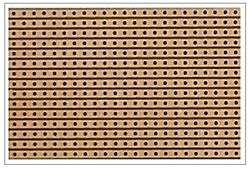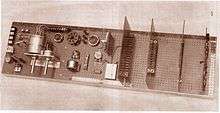Veroboard
Veroboard is a brand of stripboard, a pre-formed circuit board material of copper strips on an insulating bonded paper board which was originated and developed in the early 1960s by the Electronics Department of Vero Precision Engineering Ltd (VPE). It was introduced as a general-purpose material for use in constructing electronic circuits - differing from purpose-designed printed circuit boards (PCBs) in that a variety of electronics circuits may be constructed using a standard wiring board.
 Veroboard piece | |
| Product | Electronic component |
|---|---|
| Inventor | Terry Fitzpatrick |
| Company | Vero Electronics Ltd |
| Country | UK |
| Availability | 1960 - present |
| Current suppliers
Vero Technologies Ltd http://www.verotl.com/ Pixel Print Ltd (N. America) http://www.veroboard.com/ | |
The first single-size Veroboard product was the forerunner of the numerous types of prototype wiring board which, with worldwide use over five decades, have become known as stripboard.
The generic terms 'veroboard' and 'stripboard' are now taken to be synonymous.
History

By the mid-1950s, the printed circuit board (PCB) had become commonplace in electronics production.[1]
In early 1959, the VPE Electronics Department was formed when managing director Geoffrey Verdon-Roe hired two former Saunders-Roe Ltd employees, Peter H Winter (aircraft design department) and Terry Fitzpatrick (electronics division).
After the failure of a project to develop machine tool control equipment, the department remained operative as a result of success with the invention and development of the new electronics material - Veroboard.
New equipment using PCBs was displayed at the 1959 Radio and Electronics Components Manufacturers Federation (RECMF) Exhibition held in The Dorchester Hotel, Park Lane, London.[2]
The usual configuration for most of the PCBs of that time had components placed in a regular pattern with the circuit formed by maze-like conductive pathways. An interesting alternative, proposed by Fitzpatrick after visiting the RECMF Exhibition on behalf of VPE, envisaged a standard circuit board carrying straight-line conductors on which the components could be suitably dispersed and connected to the conductors to produce the required circuit.
A patent application was immediately filed 25 May 1959[3] and the invention was developed for Vero by associates Winter, Fitzpatrick and machine shop engineers.
Production
Production of the proposed new product, Veroboard, was undertaken by the VPE machine tool department.
Bought-in sheets of 1.6 mm (0.06 in) copper-clad SRBP printed circuit material were cut to give 122 mm x 456 mm (4.8 in x 18 in) size boards with the individual boards then being machined to form the final product according to the original Veroboard specification.[4] A multiple milling cutter tool, which comprised a bank of side-and-face cutters with suitably shaped cutting teeth, was fabricated - to be used in removing part of the bonded copper on each board leaving 21 conductive strips.[5]
For a second operation a special tool with 63 hardened punch bits 1.35 mm (0.052 in) in diameter mounted on a solid base block was constructed to repeat-punch a matrix of holes, on 0.2 in (5.1 mm) spacing, through the copper strips and the base board.
Many dimensional, material quality, and tooling problems were encountered before finished boards of acceptable quality could be produced in quantity. These machining problems were encountered due to the non-availability, in 1960, of advanced printed circuit board milling and drilling techniques or facilities for chemical milling (etching) the copper strips.
In 1961, as production rates improved with experience, Vero Electronics Ltd was formed as a separate company to market the increasing sales of Veroboard.
Use
As with other stripboards, in using Veroboard, components are suitably positioned and soldered to the conductors to form the required circuit. Breaks can be made in the tracks, usually around holes, to divide the strips into multiple electrical nodes enabling increased circuit complexity.
This type of wiring board may be used for initial electronic circuit development, to construct prototypes for bench testing or in the production of complete electronic units in small quantity.
Veroboard was first used for prototype construction within Vero Electronics Department in 1961. The images of a binary decade counter sub-unit clearly show both the assembled components and the copper conductors with the required discontinuities.

A number of these sub-units were interconnected through connectors mounted on a motherboard similar to that shown in the Veroboard Display image and comprised a very early PCB-based backplane system. Each sub-unit had a digital capacity equivalent to 1/2 byte of data storage - i.e. 2,000,000 would be required to store 1 megabyte.
Two forms of Veroboard are produced with hole pitch of 2.54 mm (0.1 in) or 3.5 mm (0.15 in). The larger pitch is and was considered easier to assemble, especially at a time when many constructors were still more familiar with valves and tag strips.
The increasingly popular integrated circuits in dual in-line packages would only fit the 0.1 boards. Very soon 0.1 pitch became by far the dominant form. Integrated circuits and the common layout of short parallel strips protruding from the sides of an IC package encouraged the development of specialist boards such as Verostrip. This was a long, thin board with the copper strips arranged transversely, rather than the usual lengthwise. A ready-cut central gap was provided to isolate the sides of the IC.
A 1979 Vero Electronics Ltd production drawing shows a special Veroboard product made for RS Components Ltd.[6] The versatility of the veroboard/stripboard type of product is demonstrated by the large number of design examples currently (2013-07) to be found on the Internet.[7]
Update
The advent of the Arduino integrated development environment, designed to introduce computer programming to newcomers unfamiliar with software development, presents a new opportunity to use Veroboard.[8] Arduino development regularly involves the use of 'shields', which plug into the main Arduino board using standard 0.1 in header connections and carry project-specific I/O hardware. However the Arduino design makes this difficult, as one of the four header sockets is offset from the 0.1 in spacing of the others by 0.05 in.
The British company Vero Technologies Ltd currently holds the UK trademark for Veroboard.[9] In the Americas the Veroboard trademark is now held by the Canadian company Pixel Print Ltd. of Vancouver.[10]
See also
References
- Kearney, Georgina (19 February 2016). "The History of Printed Circuit Boards". mint-tek.com. Mint Tek Circuits. Retrieved 24 April 2020.
- The Dorchester Hotel has no existing record for 1959 events.
- London, The Patent Office (27 November 2013). "Veroboard Patent" (scan). Retrieved 24 April 2020.
- "Veroboard Specification 1960".,Wikimedia Commons
- "Side-and-face Mill Cutter".Google Images
- "Veroboard product for RS Components" (PDF).,Vero Electronics production drawing
- "Veroboard Design Examples".Google Images
- Chantrell, Nathan. "'Veroduino'".
- UK Trademark 824,961, Intellectual Property Office website
- Veroboard.com. "Pixel Print".